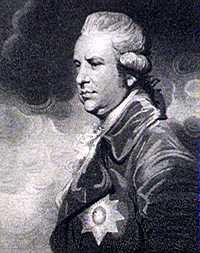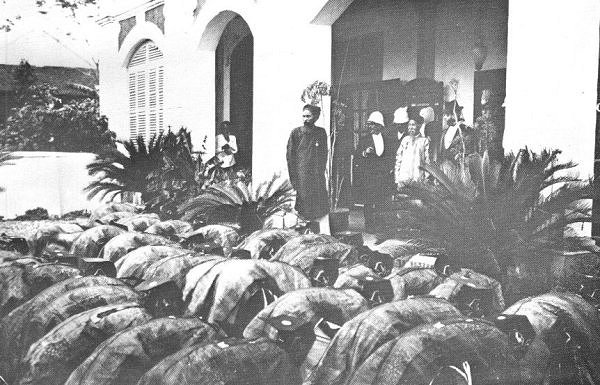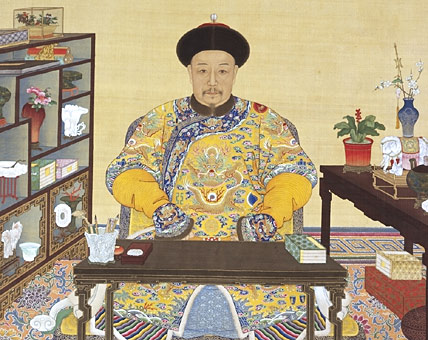|
William Amherst, 1st Earl Amherst
William Pitt Amherst, 1st Earl Amherst (14 January 177313 March 1857) was a British diplomat and colonial administrator who served as the Governor-General of the Presidency of Fort William from 1823 to 1828. Background and education Born at Bath, Somerset, Amherst was the son of William Amherst and Elizabeth, daughter of Thomas Paterson. He was the grand-nephew of Jeffrey Amherst, 1st Baron Amherst, and succeeded to his title in 1797 according to a special remainder in the letters patent. He matriculated at Christ Church, Oxford on 13 October 1789, receiving a BA in 1793 and an MA in 1797. Ambassador extraordinary to China In 1816 he was sent as ambassador extraordinary to the court of China's Qing dynasty, with a view of establishing more satisfactory commercial relations between China and Great Britain. On arriving at Pei Ho (Baihe, today's Haihe), he was given to understand that he could only be admitted to the Jiaqing Emperor's presence on condition of performing the ... [...More Info...] [...Related Items...] OR: [Wikipedia] [Google] [Baidu] [Amazon] |
The Right Honourable
''The Right Honourable'' (abbreviation: The Rt Hon. or variations) is an honorific Style (form of address), style traditionally applied to certain persons and collective bodies in the United Kingdom, the former British Empire, and the Commonwealth of Nations. The term is predominantly used today as a style associated with the holding of certain senior public offices in the United Kingdom, Canada, New Zealand, and, to a lesser extent, Australia. ''Right'' in this context is an adverb meaning 'very' or 'fully'. Grammatically, ''The Right Honourable'' is an adjectival phrase which gives information about a person. As such, it is not considered correct to apply it in direct address, nor to use it on its own as a title in place of a name; but rather it is used in the Grammatical person, third person along with a name or noun to be modified. ''Right'' may be abbreviated to ''Rt'', and ''Honourable'' to ''Hon.'', or both. ''The'' is sometimes dropped in written abbreviated form, but is ... [...More Info...] [...Related Items...] OR: [Wikipedia] [Google] [Baidu] [Amazon] |
William Amherst (British Army Officer)
Lieutenant-General William Amherst (5 February 1732 – 13 May 1781) was a British Army officer and politician. During the Seven Years' War, he led British forces that recaptured St. John's, Newfoundland from the French at the 1762 Battle of Signal Hill. Early life William Amherst was born, in Sevenoaks, Kent, into a family of lawyers. He married Elizabeth Amherst (Patterson). Their children included: * William Pitt Amherst, 1st Earl Amherst of Arracan, GCH, PC, a future Governor-General of India * Elizabeth Frances Amherst Seven Years' War Amherst was commissioned as an ensign in the First Regiment of Foot Guards in 1755. He eventually rose to the rank of lieutenant general in 1779. As a lieutenant colonel, Amherst was instrumental in the re-capture of St. John's from the French in 1762 at the Battle of Signal Hill. An area near Signal Hill at the entrance of St. John's harbour is named " Fort Amherst" in commemoration of his victory in 1762. In 1766 he becam ... [...More Info...] [...Related Items...] OR: [Wikipedia] [Google] [Baidu] [Amazon] |
HMS Alceste (1806)
HMS ''Alceste'' was built at Rochefort, Charente-Maritime, Rochefort in 1804 for the French Navy as ''Minerve'', an . In the spring of 1806, prior to her capture, she engaged , then under Thomas Cochrane, 10th Earl of Dundonald, Lord Cochrane. During the duel she ran aground but Cochrane had to abort his attack when French reinforcements appeared. The British captured her in an action on 25 September 1806, and the Royal Navy took ''Minerve'' into service as ''Alceste'' in March 1807; ''Alceste'' then continued to serve throughout the Napoleonic Wars. On Action of 29 November 1811, 29 November 1811, ''Alceste'' led a British squadron that captured a French military convoy carrying more than 200 cannon to Trieste in the Balkans. After this loss, Napoleon changed the direction of his planned eastward expansion in 1812 from the Balkans to Russia. The British historian James Henderson has suggested that the two events were linked, and may have changed the course of the war. In 181 ... [...More Info...] [...Related Items...] OR: [Wikipedia] [Google] [Baidu] [Amazon] |
Beijing
Beijing, Chinese postal romanization, previously romanized as Peking, is the capital city of China. With more than 22 million residents, it is the world's List of national capitals by population, most populous national capital city as well as China's List of cities in China by population, second largest city by urban area after Shanghai. It is located in North China, Northern China, and is governed as a Direct-administered municipalities of China, municipality under the direct administration of the Government of the People's Republic of China, State Council with List of administrative divisions of Beijing, 16 urban, suburban, and rural districts.Figures based on 2006 statistics published in 2007 National Statistical Yearbook of China and available online at archive. Retrieved 21 April 2009. Beijing is mostly surrounded by Hebei Province and neighbors Tianjin to the southeast; together, the three divisions form the Jing-Jin-Ji, Jing-Jin-Ji cluster. Beijing is a global city and ... [...More Info...] [...Related Items...] OR: [Wikipedia] [Google] [Baidu] [Amazon] |
Mandarin (bureaucrat)
A mandarin () was a bureaucrat scholar in the history of China, Korea and Vietnam. The term is generally applied to the officials appointed through the imperial examination system. History and use of the term The English term comes from the Portuguese ''mandarim'' (spelled in Old Portuguese as ''mandarin,'' ). The Portuguese word was used in one of the earliest Portuguese reports about China: letters from the imprisoned survivors of the Tomé Pires embassy, most likely written in 1524, and in Castanheda's ''História do descobrimento e conquista da Índia pelos portugueses'' (c. 1559). Matteo Ricci, who entered mainland China from Portuguese Macau in 1583, also said the Portuguese used the word. The Portuguese word was thought by many to be related to ''mandador'' ("one who commands") and ''mandar'' ("to command"), from Latin ''mandare''. Modern dictionaries, however, agree that the Portuguese borrowed it from the Malay ''menteri'' (in Jawi: , ), which derived fr ... [...More Info...] [...Related Items...] OR: [Wikipedia] [Google] [Baidu] [Amazon] |
George Macartney, 1st Earl Macartney
:''George Macartney should not be confused with Sir George Macartney, a later British statesman.'' George Macartney, 1st Earl Macartney, (14 May 1737 – 31 May 1806) was a British diplomat, politician and colonial administrator who served as the governor of Grenada, Madras and the Cape Colony. He is often remembered for his observation following Britain's victory in the Seven Years' War and subsequent territorial expansion at the Treaty of Paris that Britain now controlled " a vast Empire, on which the sun never sets". Early years He was born in 1737 as the only son of George Macartney, High Sheriff of Antrim and Elizabeth Winder. Macartney descended from a Scottish family with origins in Ireland, who were granted land in Scotland for serving under Edward Bruce, brother of Robert the Bruce. The Macartneys of Auchenleck, Kirkcudbrightshire settled in Lissanoure County Antrim, Ireland, where he was born. After graduating from Trinity College Dublin, in 1759, he became a st ... [...More Info...] [...Related Items...] OR: [Wikipedia] [Google] [Baidu] [Amazon] |
Sir George Staunton, 2nd Baronet
Sir George Thomas Staunton, 2nd Baronet, , (26 May 1781 – 10 August 1859) was a British writer, orientalist and politician. Early life Born at Milford House near Salisbury, he was the son of Sir George Leonard Staunton (1737–1801), first baronet, diplomatist and Orientalist. In 1792, at the age of 12, he accompanied his father, who had been appointed secretary to Lord Macartney's mission to China, to the Far East (1792–1794). Prior to the trip the young George Staunton had begun to learn Chinese alongside Sir John Barrow, 1st Baronet and for the duration was therefore given the role of Page to Lord Macartney. During the mission his Chinese proved good enough to engage in diplomatic banter and he received a personal gift from the Qianlong Emperor. In 1797 he spent two terms at Trinity College, Cambridge. In the employ of the East India Company In 1798 was appointed a writer in the British East India Company's factory at Canton (Guangzhou), and subsequently its chief. D ... [...More Info...] [...Related Items...] OR: [Wikipedia] [Google] [Baidu] [Amazon] |
Kowtow
A kowtow () is the act of deep respect shown by prostration, that is, kneeling and bowing so low as to have one's head touching the ground. In East Asian cultural sphere, Sinospheric culture, the kowtow is the highest sign of reverence. It was widely used to show reverence for one's elders, superiors, and especially the Emperor of China, as well as for religious and cultural objects of worship. Terminology The word Kowtow is derived from / ( zh, first=j, j=kau3 tau4, p=kòutóu). An alternative Chinese term is / ( zh, p=kētóu, j=hap6 tau4); however, the meaning is somewhat altered: has the general meaning of ''knock'', whereas has the general meaning of "touch upon (a surface)", / meaning head. The date of this custom's origin is probably sometime during the Spring and Autumn period or the Warring States period of China's history (771–221 BC), because it was a custom by the time of the Qin dynasty (221–206 BC). Traditional usage In Imperial era of Chinese history, ... [...More Info...] [...Related Items...] OR: [Wikipedia] [Google] [Baidu] [Amazon] |
Jiaqing Emperor
The Jiaqing Emperor (13 November 1760 – 2 September 1820), also known by his temple name Emperor Renzong of Qing, personal name Yongyan, was the sixth emperor of the Qing dynasty and the fifth Qing emperor to rule over China proper. He was the 15th son of the Qianlong Emperor. During his reign, he prosecuted Heshen, the corrupt favorite of his father and attempted to restore order within the empire while curbing the smuggling of opium into China. Assessments of his reign are mixed, either seen as the "beginning of the end" of the Qing dynasty, or as a period of moderate reform that presaged the intellectual movements of the 1860s. Early years Yongyan was born in the Old Summer Palace, 8 km (5 mi) northwest of the walls of Beijing. His personal name, "Yongyan" (永琰), was later changed to "Yongyan" (顒琰) when he became the emperor. The Chinese character for ''yong'' in his name was changed from the more common 永 to the less common 顒. This novelty was ... [...More Info...] [...Related Items...] OR: [Wikipedia] [Google] [Baidu] [Amazon] |
Hai River
The Hai River (海河, lit. "Sea River"), also known as the Peiho, ("White River"), or Hai Ho, is a Chinese river connecting Beijing to Tianjin and the Bohai Sea. During the Song dynasty, the main stream of the Hai River was called the lower section of the Jie River. In the Jin and Yuan dynasties, it was renamed as Zhígǔ River (直沽河, lit. “Straight Gu River") and Dàgǚ River (大沽河, lit. “Great Gu River") respectively. The name Hai River first appeared towards the end of the Ming dynasty. The Hai River at Tianjin is formed by the confluence of five watercourses: the Southern Canal, Ziya River, Daqing River, Yongding River, and the Northern Canal. The southern and northern canals are parts of the Grand Canal. The Southern Canal is joined by the Wei River at Linqing. The Northern Canal joins with the Bai He (or Chaobai River) at Tongzhou. The Northern Canal (sharing a channel with Bai He) is also the only waterway from the sea to Beijing. Therefore, earl ... [...More Info...] [...Related Items...] OR: [Wikipedia] [Google] [Baidu] [Amazon] |
Qing Dynasty
The Qing dynasty ( ), officially the Great Qing, was a Manchu-led Dynasties of China, imperial dynasty of China and an early modern empire in East Asia. The last imperial dynasty in Chinese history, the Qing dynasty was preceded by the Ming dynasty and succeeded by the Republic of China (1912–1949), Republic of China. At its height of power, the empire stretched from the Sea of Japan in the east to the Pamir Mountains in the west, and from the Mongolian Plateau in the north to the South China Sea in the south. Originally emerging from the Later Jin (1616–1636), Later Jin dynasty founded in 1616 and proclaimed in Shenyang in 1636, the dynasty seized control of the Ming capital Beijing and North China in 1644, traditionally considered the start of the dynasty's rule. The dynasty lasted until the Xinhai Revolution of October 1911 led to the abdication of the last emperor in February 1912. The multi-ethnic Qing dynasty Legacy of the Qing dynasty, assembled the territoria ... [...More Info...] [...Related Items...] OR: [Wikipedia] [Google] [Baidu] [Amazon] |
Earl Amherst
Earl Amherst (), of Arracan in the East Indies, was a title in the Peerage of the United Kingdom. It was created on 19 December 1826, for William Amherst, 2nd Baron Amherst, the Governor-General of India. He was made Viscount Holmesdale, in the County of Kent, at the same time, also in the Peerage of the United Kingdom. Lord Amherst had succeeded his uncle Jeffery Amherst, 1st Baron Amherst, as second Baron Amherst in 1797. The latter was a distinguished military commander best known as one of the victors of the French and Indian War. In 1776, he was raised to the Peerage of Great Britain as Baron Amherst, of Holmesdale in the County of Kent, with normal remainder to heirs male of his body. In 1788, he was created Baron Amherst, of Montreal in the County of Kent, also in the Peerage of Great Britain, with special remainder to his nephew William Pitt Amherst and the heirs male of his body. The 1776 barony became extinct on his death in 1797, while he was succeeded in the 177 ... [...More Info...] [...Related Items...] OR: [Wikipedia] [Google] [Baidu] [Amazon] |






